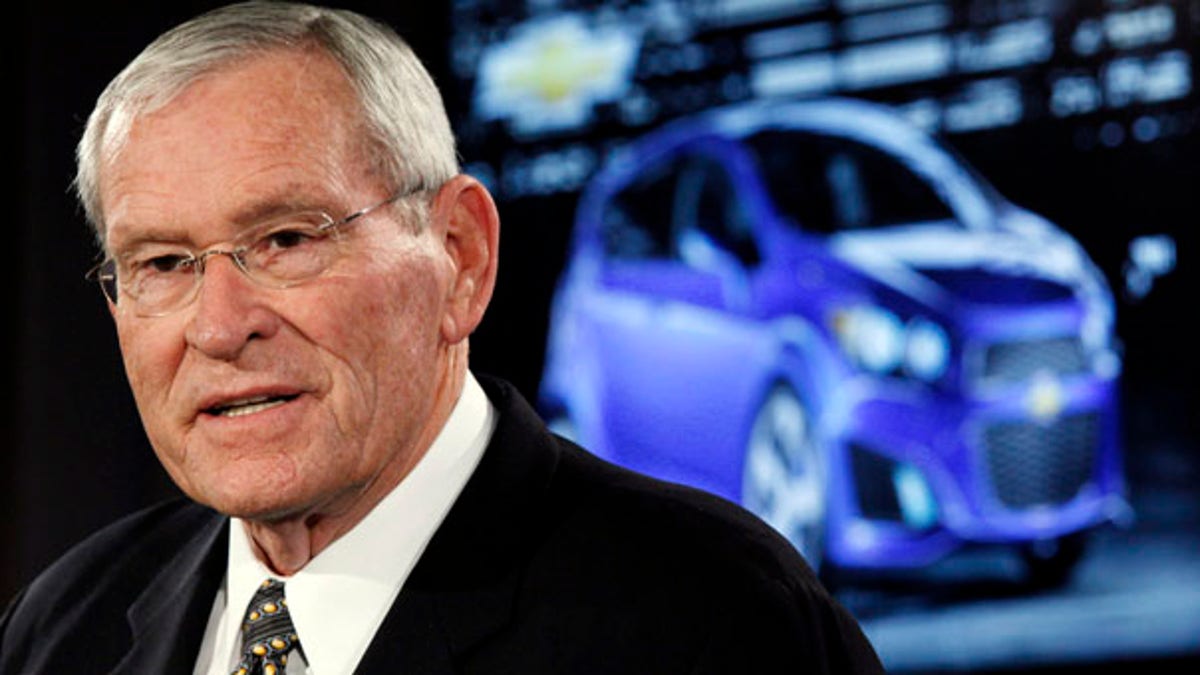
FILE: General Motors Chairman and CEo Ed Whitacre (AP)
General Motors Co. CEO Ed Whitacre announced Thursday after reporting second-quarter earnings that he will step down Sept. 1.
The auto giant will replace Whitacre with board member Dan Akerson, the managing director and head of global buyout of The Carlyle Group. He was a former CEO of Nextel Communications.
Akerson, 61, will be GM's fourth CEO in 18 months when he takes over the job.
Whitacre, a former AT&T chairman and CEO, was brought in to run the car maker after it emerged from bankruptcy last year. He will remain GM's chairman.
GM, which still owes $43.4 billion in bailout funds, said that it earned $1.33 billion in the second quarter, setting it on a path to begin one of the largest ever corporate stock offerings -- aimed at raising money to repay taxpayers.
It was the second straight quarterly profit for GM, which made $865 million in the first quarter.
Whitacre said last week an initial public offering would lead GM to end its dependence on the government, whose investment gave it a majority stake in the company.
But those plans may be premature. While GM made $2.2 billion in profits in the first half of 2010, investors may not be impressed. GM lost $88 billion in the five years before it filed for bankruptcy protection last June.
On top of that, GM's profits second quarter revenues were $33.2 billion, up 5.3 percent from the first quarter, and it earned $2.55 during that time, but a year earlier, when it was in bankruptcy protection, the car company lost $12.9 billion or $21.12 a share, GM reported Thursday.
So far, GM's results are a reversal of fortune from 2009, when it lost $4.3 billion from July 10, the day it exited bankruptcy court, through Dec. 31. Before the first-quarter results, GM hadn't reported a profit since the second quarter of 2007.
GM said it ended the quarter with $32.5 billion in cash, down from $36 billion in the first quarter.
According to the Detroit automaker, sales in the second quarter grew in every region except Europe. In the U.S., GM saw strong sales of new and redesigned models like the Chevrolet Equinox wagon and Buick LaCrosse sedan.
GM has been working to streamline operations and slash costs. It has shed four brands, changed leadership and last week announced its U.S. dealership network would number 4,500, about 25 percent smaller than it was in early 2009.
But it still faces hurdles. GM's U.S. sales rose 14 percent in the first six months of this year compared to the same period in 2009, according to AutoData Corp. That was slightly less than the average industry increase of 17 percent. GM had the highest incentive spending of any major automaker at $3,691 per vehicle, almost $1,000 more than the industry average, according to Edmunds.com.
By comparison in the second quarter of 2010, Ford Motor Co. made $2.6 billion, its fifth straight quarterly profit. Chrysler Group LLC, which got $15.5 billion in federal aid, narrowed its second-quarter loss to $172 million.
GM has also relied heavily on sales to rental-car, government and corporate fleets, which are less profitable than sales to individual customers. Retail sales -- or sales to individuals -- were up 11 percent industry wide through June, but up only 1 percent at GM.
The U.S. government has owned a 61 percent stake in GM since the company left bankruptcy protection.
"We want the government out. Period," Whitacre said during an auto conference in northern Michigan. "We don't want to be known as Government Motors."
GM has already paid $6.7 billion in government loans. Whitacre said GM wants to sell its stock all at once, rather than in batches, which would end the government's ownership more quickly.
But the U.S. government and GM's other stakeholders — a United Auto Workers health-care trust, which owns 17.5 percent of the company; the Canadian government, which owns 11.7 percent; and old bondholders, who own 9.8 percent — will ultimately decide how much of their equity to sell.
A GM IPO could be the largest such sale in U.S. history. It would have to bring in $70 billion to pay back all of GM's stakeholders; some analysts expect the IPO will be worth at least than much. That would be more than Ford's market value of roughly $44 billion, but less than the total value of Toyota's shares of about $113 billion.
It would also dwarf a 2008 offering by Visa Inc. that netted nearly $18 billion.
GM is taking steps to boost its U.S. sales. In July the company said it would buy AmeriCredit Corp., an automotive financing company that serves the subprime market, for $3.5 billion. Though it was partners with Ally Financial Inc., formerly known as GMAC, GM previously lacked a so-called captive financing company, which can offer better rates to customers than outside financial sources.
GM also has several new vehicles in the pipeline. Its new Chevrolet Cruze, due out next month, is GM's latest bid to make a desirable -- and profitable -- small car. Later this year, the company will begin selling the Chevrolet Volt, a $41,000 electric car with a small gas engine that extends its range.
The Associated Press contributed to this report.

